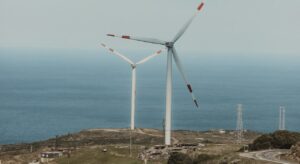Thermal power plants (TPPs) are the most powerful power plants located at fuel extraction sites. TPPs, which use calorific, transportable fuel, are focused on consumers.
It is worth bearing in mind that its design may include several circuits – the coolant from the fuel reactor may not go directly to the turbine, but give its heat in the heat exchanger to the heat carrier of the next circuit, which can already go to the turbine, and may pass its energy to the next circuit. Also in any power plant there is a system for cooling the spent coolant in order to bring the coolant temperature to the required value for the repeated cycle.
If there is a settlement near the power plant, the spent coolant heat is used to heat water for home heating or hot water supply, and if not, the excess heat of the spent coolant is simply discharged into the atmosphere in cooling towers or into a water body (pond, lake, river) cooler.
Thermal power plants produce electrical energy by converting the heat energy released during the combustion of fossil fuels. Most thermal power plants use thermal steam turbine units, which use thermal energy in a steam generator to produce high-pressure water steam, which drives a steam turbine rotor connected to the rotor of an electric generator (usually a synchronous generator). As fuel at such TPPs coal (mainly), fuel oil, natural gas, lignite, peat, oil shale are used.
TPPs with CCPs, having condensing turbines as power generator drives and not using exhaust steam heat to supply heat to external consumers, are called condensing power plants (CCPPs or GRESs). TPPs with CCPs, equipped with cogeneration turbines and giving the heat of exhaust steam to industrial or municipal consumers, are called combined heat and power plants (CHPPs).
TPPs with a gas turbine drive of an electric generator are called TPPs with gas turbine units (GTU). In the GTU combustion chamber gas or liquid fuel is burned; combustion products with a temperature of 750 … 900°С go to the gas turbine, rotating the electric generator. The efficiency of such TPPs usually makes 26 … 28 %, the capacity – up to several hundreds of MW. TPPs with GTUs are usually used to cover peaks of electric load.
Thermal power plants can be equipped with a combined cycle plant (CCPP), consisting of a steam turbine and a gas turbine unit. The efficiency of such a power plant can reach 42…43 %. GTUs and CCUs can also supply heat to external consumers, i.e. they can operate as combined heat and power plants. Thermal power plants use widespread fuel resources, are relatively freely located and can generate electricity without seasonal fluctuations. They are built quickly and are associated with less labor and material costs. But thermal power plants have significant disadvantages. They use non-renewable resources, have low efficiency (30…35 %), have an extremely negative impact on the environmental situation.
Thermal power plants around the world emit 200 … 250 million tons of ash and about 60 million tons of sulfur dioxide into the atmosphere every year, and absorb a huge amount of oxygen. It was found that coal in microdoses almost always contains U238, Th232 and radioactive carbon isotope.
The primary role among thermal plants is played by condensing power plants (CPPs). They gravitate both to fuel sources and consumers and are therefore very widespread. The larger the CHPP, the farther it can transmit electric power, i.e. as its capacity increases, the influence of the fuel and energy factor increases. CHPPs (combined heat and power plants) are units for combined production of electricity and heat. Their efficiency is up to 70 % against 32…38 % at CHPPs. CHPs are tied to consumers, because the radius of heat (steam, hot water) transmission is 15…20 km. The maximum capacity of CHPPs is less, than of CHPPs. Currently there are some brand new units:
Gas turbine (GTU) plants, in which gas turbines are used instead of steam turbines, which removes the problem of water supply;
Combined-cycle gas turbine (CCGT) units, where the exhaust heat is used to heat water and produce low-pressure steam;
Magnetohydrodynamic generators (MHD-generators), which convert heat directly into electric power.

